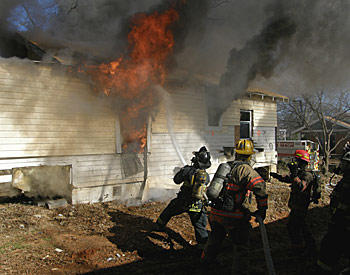
Firefighters in Spartanburg, S.C., battle a 'test burn' of an abandoned house in an experiment to demonstrate new techniques for combating flashover, an extremely dangerous phenomenon in fires. Researchers from NIST, the International Society of Fire Service Instructors, and state and local fire and safety officials participated in the tests the week of Jan. 20, 2013. [Note to editors: Additional photos are available.]
Fire researchers from the National Institute of Standards and Technology (NIST) and colleagues from fire service organizations will turn abandoned wood-frame, single-family houses near the site of an old Spartanburg, S.C., textile mill into proving and training grounds for new science-driven fire-fighting techniques this week. The objective of the study is to improve firefighter safety and effectiveness.
Experiments conducted in eight different houses will demonstrate fire-fighting methods—individually and in combinations—for strategically ventilating and isolating fires to prevent—or at least delay—flashover, the extremely perilous phenomenon that occurs when heat builds up in a burning structure's contents and components to the point that they burst into flames simultaneously.
In conjunction with the experiments, the International Society of Fire Service Instructors (IFSI) will videotape how firefighters implement size-up, flowpath control, and exterior fire attack, also known as transitional attack. The IFSI will then develop training modules that will be available to firefighters across the country.
Other collaborators in the field experiments include the International Society of Fire Service Instructors, the South Carolina Fire Academy, the Spartanburg Fire Department, the South Carolina State Fire Marshal's Office and the Spartanburg Public Safety Office. The project is funded with a DHS/FEMA Assistance to Firefighters Grant.
In July 2012, in another team effort, NIST fire researchers gathered data in experimental burns in 20 abandoned townhouses on New York's Governors Island, about a kilometer from the southern tip of Manhattan.
The Spartanburg fire tests are being conducted in an area slated for a major redevelopment initiative.

